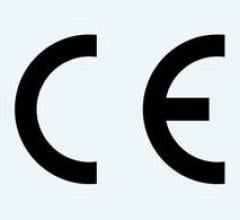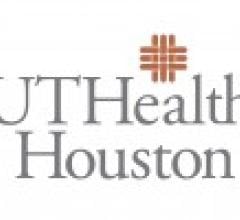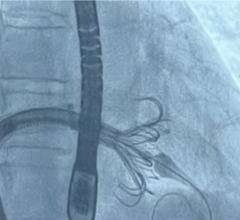
The Sapien transcatheter aortic heart valve was the star device highlighted at ACC 2011.
April 11, 2011 — The following is a roundup of key news and trial data that came out of the American College of Cardiology (ACC) 2011 Scientific Session in New Orleans last week.
Transcatheter Valve Repair Performs Very Well
The key take-away message was that transcatheter heart valve repair will likely replace surgery as the standard-of-care in the next decade. That’s not explicitly what the experts and trial presenters said, but that’s what I read between the lines from the overwhelmingly positive results from the PARTNER and EVEREST trials. Both pitted transcatheter valve repair against surgical repair in the sickest of patients, and in view of the positive results showing transcatheter technology on par with surgical repair, it begs the question of how transcatheter valves would perform in much healthier patients.
There was so much interest generated by the results of the PARTNER (Placement of AoRTic TraNscathetER Valve) trial at ACC that the main auditorium was packed to capacity with a standing-room-only crowd. Convention center staff turned people away at the door and redirected them to another room where they could watch the results being presented via video link. That room, too, quickly filled with more than 250 attendees.
One-year data from PARTNER Cohort A (transcatheter aortic valve implantation [TAVI] vs. surgery in high-risk surgical patients) concluded that survival of patients treated with the Edwards Sapien transcatheter aortic valve was equivalent to those treated with surgical aortic valve replacement. All-cause mortality in TAVI patients was 24.2 percent, versus 26.8 percent for surgical valve replacement. Even with this early-generation device and limited operator experience, the TAVI mortality was the lowest reported in any multi-center series of clinical data for the Sapien valve.
The EVEREST II study (Endovascular Valve Edge-to-Edge REpair STudy) shows the Abbott MitraClip transcatheter mitral valve repair system also continues to compare favorably with conventional open-heart surgery for treatment of mitral regurgitation. At two years, 78 percent of patients with the device did not need surgery, and major adverse events at 30 days were significantly lower in the percutaneous group over surgical repair (15 vs. 47.9 percent).
Durability and anti-clotting drugs are other issues considered in this research. A mechanical heart valve lasts 35 years and requires the patient to take warfarin for life. Valve repair with a MitraClip should last approximately 15 years, and after implant patients take clopidogrel for just one month and aspirin for six months.
For more details on EVEREST II, visit www.dicardiology.net/article/trial-data-show-benefits-mitral-valve-clip-after-two-years. For more on PARTNER, visit www.dicardiology.net/article/partner-trial-shows-excellent-outcomes-transcatheter-aortic-valve.<
Transradial Offers Fewer Bleeding Complications
The RIVAL trial compared outcomes of radial vs. femoral access in angioplasty procedures. In the largest randomized trial to compare these methods of access, researchers found radial reduced rates of vascular complications. Radial access did not reduce the primary outcome measure of death, heart attack, stroke and non-CABG-related major bleeding compared to femoral access in the overall study population. The data showed these outcomes were equal for both femoral and radial access procedures. While RIVAL did not show a vast improvement in outcomes over femoral access, it was pointed out that patients overwhelmingly preferred radial to femoral access because of increased comfort and immediate ambulation and said they would prefer radial on subsequent procedures, suggesting patient preference might become the biggest driver for conversion to radial access in the United States. To read more, visit www.dicardiology.net/article/rival-trial-radial-access-reduces-vascular-complications.
Bioresorbable Stent Shows Continued Positive Outcomes
The second phase of a trial evaluating the world’s first drug-eluting bioresorbable vascular scaffold (BVS) showed positive one-year results. Data from the ABSORB trial, which looked at Abbott’s BVS, demonstrated a 6.9 percent rate of major adverse cardiac events (MACE) and no reports of thromboses. In an analysis of 56 of the 101 patients, there was a late loss of 0.27 mm, which is comparable to data on drug-eluting stents. However, unlike metal stents, vasomotor function returned as the BVS dissolved. For more information, www.dicardiology.net/article/bioresorbable-stent-demonstrates-positive-one-year-results.
Stenting Equal to CABG, but Long-Term Patency Questioned
Sirolimus-eluting stents were shown to equal coronary artery bypass surgery (CABG), but questions remain about long-term durability in a South Korean study. The rates of death, heart attack and stroke were equal for patients in the PRECOMBAT trial, regardless of whether they received a stent or CABG.<br><br>However, there does seem to be some divergence in revascularization rates as time goes on, showing CABG may have better durability than stenting. For more, visit www.dicardiology.net/article/stenting-equal-cabg-precombat-trial.
Bioresorbable Polymer Shows Better Stenting Outcomes
One-year data from the RESOLUTE U.S. trial showed the Resolute zotarolimus-eluting stent using a new biocompatible polymer achieved a lower rate of restenosis and stent thrombosis compared to the Endeavor stent. Out of 1,112 patients who received the stent, only two cases of stent thrombosis were reported – the lowest stent thrombosis rate ever reported in a large-scale drug-eluting stent trial. For more information, visit www.dicardiology.net/article/biocompatible-polymer-reduces-lesion-failure-thrombosis-compared-endeavor.
Percutaneous Pump Offers More Support than IABPs
Final data from the PROTECT II study showed better hemodynamic support was offered by the Impella 2.5 percutaneous ventricular assist device over the standard-of-care intra-aortic balloon pump (IABP). The trial looked at support delivered to patients with severely reduced ejection fractions undergoing high-risk percutaneous coronary interventions (PCI). Data showed the device offered a 21 percent reduction in major adverse events at 90 days. For more details, visit www.dicardiology.net/article/high-risk-pci-patients-get-more-support-impella-vs-iabp.
DES Perform Better than BMS in Vein Grafts
The ISAR-CABG trial — the largest randomized, multi-center study comparing drug-eluting stents (DES) and bare-metal stents (BMS) placed in saphenous vein graft lesions — showed better outcomes for DES. Researchers found DES led to a lower combined rate of death, heart attack and repeat revascularization. For more details, view www.dicardiology.net/article/no-difference-seen-des-vs-bare-metal-stents-narrowing-saphenous-vein-grafts.
PPI Effects on Clopidogrel Vary by Drug
A study evaluating the potential inhibitory effects of proton pump inhibitors (PPIs) on clopidogrel (Plavix) showed the antiplatelet agent’s active metabolite and inhibition of platelet function were reduced less with dexlansoprazole (Dexilant) or lansoprazole, rather than esomeprazole. For more, visit www.dicardiology.net/article/new-study-results-show-ppi-effects-clopidogrel.
Other Highlights
Perhaps the most fun and interesting news coming out of ACC was a computed tomography angiography (CTA) study of ancient Egyptian mummies, which dispelled the myth that atherosclerosis is a modern disease. Plaque was clearly revealed throughout many of the preserved bodies, some as old as 3,550 years. To read more and see images of the plaque, go to www.dicardiology.net/article/egyptian-mummies-show-earliest-cases-coronary-disease-ct.
For a list of the editor’s choice of interesting or helpful new technology on the expo floor, visit www.dicardiology.net/content/editors-top-picks-innovative-new-technology-acc-2011. Items include ECG management system integration with the iPad and smart phones, CT-like image quality enhancement for ultrasound images using new advanced visualization software, and a stethoscope that integrates a six-lead ECG system.
Of all the take-away messages I received in April at the American College of Cardiology (ACC) 2011 Scientific Session in New Orleans, foremost in my mind is that even cardiologists like to party. Bourbon Street was filled with cardiologists each night during ACC. They stuck out because no one else would have worn highly-polished designer leather shoes and sports coats on Bourbon Street on a Sunday night. At one jazz club, if it weren’t for the ACC being in town, it would have been a slow night, since cardiologists made up 75 percent of the audience.


 April 29, 2025
April 29, 2025 








